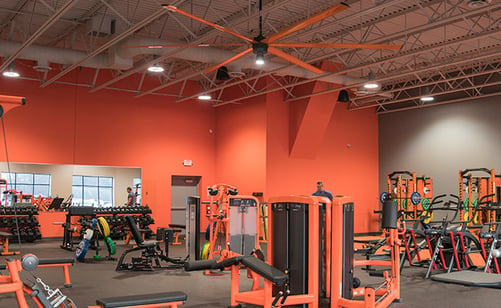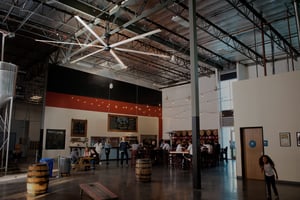Big industrial ceiling fans have redefined how businesses regulate temperature and airflow in large...
Do Ceiling Fans Really Mean Big Air?
Does a big fan mean big air? Does it really mean MORE air? Yes, of course it does! Those really big fans are officially called HVLS fans. That stands for High Volume Low Speed. They are designed to create comfortable airflow throughout large spaces at a low speed. Let’s look at exactly how big air fans work and how you can apply the fans to your specific space.
The Big Science Behind Big Air Fans
MacroAir big fans use longer, slower-turning, airfoil-shaped fan blades. These blades allow the fans to move much larger amounts of air more efficiently than a standard high-speed fan. This air column is then pushed downward to the floor by the slow-rotating blades. When it contacts the floor, the air disperses evenly throughout the area. This creates a steady and gentle breeze that effectively cools occupants by circulating air.
Sometimes It’s Okay to Double Dip
Not only do big fans mean big air on their own but large fans can also be utilized as the perfect complement to HVAC systems. MacroAir HVLS ceiling fans reduce energy costs by supplementing air conditioning. This can contribute up to a 30% reduction in energy usage. So, any size warehouse can increase or decrease its thermostat by 5° F depending upon winter or summer usage. And they would see up to a 30% reduction in cooling or heating costs.
The Big Benefits of Big Air
- Evenly Circulate Air All Year Long: Big fans can evenly distribute cool air during the hot summer months by running in forward but they can also bring warm air down during the winter by running in reverse. The even air circulation also means better air quality within your building.
- Cover a Large Area at a Low Cost: Because of the large circumference and specially designed large fan blades, a single large ceiling fan can cool approximately 22,000 square feet, compared to 34 small high-speed fans to get similar results. HVLS fans also are extremely energy efficient. In fact, they cost pennies a day to run. They can literally save you up to 30% on your energy bills!
- Even Out Temperatures: Big fans are more effective for evening out the temperatures in large buildings compared to traditional small industrial fans, exhaust fans, or HVAC systems alone. This is especially important to pay attention to in industrial spaces like warehouses and distribution centers.
Tell Me More About Big Fans
Sizes
Big fans come in a variety of sizes ranging from 6-24 feet in diameter. Each fan in the MacroAir fan product line is designed with certain conditions and spaces in mind. For instance, a more industrial space, like a warehouse or distribution center is going to need a larger diameter fan. The AVDX, AVD5, AVD3, AirVolution, and AirLegacy all offer the largest diameters. They range in size from 8-24 feet in diameter. The AirLite, with a size range of 8-14 ft, and the AVD370, with a size ranging from 6-12 feet in diameter are both ideal for smaller spaces.
Ceiling height
Big ceiling fans ranging in size from 6-24 ft in diameter do have a higher clearance requirement. In fact, ceiling fan requirements are important to pay attention to. MacroAir fans have a minimum height requirement of at least 10 feet above the floor. Plus, most fans have a 3 ft drop standard, meaning your ceiling height must be at least 13 ft. Many models can be shortened to a 2 ft drop standard. The AVD370 can go as short as a one ft drop standard.
For safety reasons, you must make certain that fans are positioned so that blade tips are at least 3 feet away from any area where a person may be able to extend outward to reach them.
Size of Space
Almost any size space can accommodate a big fan. Depending on the specific size of your facility or space, our fan experts can help you identify the fan that is perfect for your area. They will also help you identify the number of fans needed to effectively help cool your space and keep your people comfortable.
When spacing fans within your room, there is a general formula you should follow. Your big fan should be 1.5 times the diameter of the fan from the wall. So, for example, if my fan was 6 feet in diameter, I would take 6 x 1.5 = 9. That means my ceiling fan should be 9 feet from the wall.
When determining how many big fans you need in your facility, consider the layout of your facility, since large spaces will require multiple fans. You also must think about the spacing between those fans. Depending on the diameter of your fan, you will take that diameter and multiply it by 3 to find the distance between fans. For example, if the diameter of my fan was 6 feet, I would take 6 x 3 = 18. That means there should be 18 feet in between my fans.
Noise Level
Many environments that need big air movement house people working in the space all day long. When you have a drum fan or other small floor fan, you often get TONS of noise with it. This can actually be dangerous for your hearing when you are exposed to it for 8 hours or more.
Big fans offer quiet air movement. In fact, HVLS fans are very quiet in comparison to smaller fans. Smaller fans can have a noise level of 80 decibels. In contrast, large ceiling fans have a noise level between 39-61 decibels depending on the size and fan type.
Many large ceiling fans offer a direct-drive motor, which cuts the noise down significantly. Direct-drive motors have quieter performance, less friction, and extremely low maintenance. Additionally, big fans are quieter because they spin at a much slower rate.
Proper fan installation is key to ensuring quiet fan operation. Many distributors and manufacturers offer professional installation, especially in larger facilities where multiple fans are needed. If you are installing a big fan yourself, MacroAir offers comprehensive and digestible installation instructions with your big fan purchase. However, it is ultimately up to the user to read them. They also offer a guide to the 5 most common HVLS fan installation mistakes.
Fitaholic Fitness Testimonial

When Damion Meyer opened his Fitaholic Fitness facilities in Minnesota, he had comfort and savings in mind. In fact, one of the first things in his building design was the placement of MacroAir fans.
“I partnered with MacroAir because I felt like they were superior in the industry with the products they provided.” - Damion Meyer, Owner, Fitaholic Fitness
Once Damion knew the placement of the MacroAir fans, the HVAC unit was designed around them. Fitaholic Fitness knows the savings MacroAir provides.
In fact, with the addition of the fans, Fitaholic Fitness was able to save considerably on their tonnage and monthly HVAC expenses. By designing the facility around MacroAir fans, the gym was able to purchase a smaller HVAC unit. Ultimately, the fans have positively affected Fitaholic's bottom line. Likewise, the fans have helped with his overall energy expenditures over the years.
When it comes to fitness, let’s face it, nothing rates higher than comfort for your members. If they are uncomfortable, beyond the workout, then they are likely to find another facility. MacroAir fans provide the proper airflow. Guests can breathe easily and they feel supported with good air quality. According to Meyer, “Macroair has delivered an end-product that has helped with not only the actual temperature gauging but also the comfort.”
“If you are struggling at that midpoint between 'this is expensive' and 'is it gonna be worth it'…I would say HANDS DOWN it’s one of the better investments that we’ve made. I hear it from my clients almost daily as to how nice it is to have good airflow.” - Damion Meyer, Owner, Fitaholic Fitness

Damion is absolutely right! Big air fans are worth the investment. You will see a reduction in your cooling costs, and they are only pennies a day to run! Find out more about the benefits of big fans by clicking the blog link below. Learn why big fans are that much better than the alternative.

